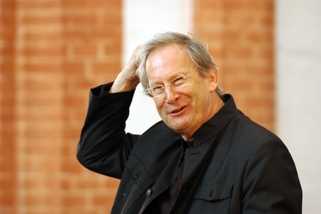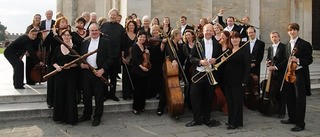|
Back
Tiger at the Gates New York
Isaac Stern Auditorium, Carnegie Hall
04/30/2015 - & April 19 (Chapel Hill), 24 (Costa Mesa), 2015
Claudio Monteverdi: Vespro della Beata Vergine
The Monteverdi Choir including soloists: Francesca Aspromonte, Francesca Boncompagni, Mariana Flores (Sopranos), Krystian Adam, Nicholas Mulroy, Andrew Tortise (Tenors), Alex Ashworth, Robert Davies (Baritones), Gianluca Buratto (Bass)
English Baroque Soloists, Sir John Eliot Gardiner (Conductor)

J. E. Gardiner (© Maciej Gozdzielewski)
Before anything, never in my concert-going life have I seen an audience, after 90 uninterrupted minutes of music, rise to their feet simultaneously, instinctively and–dare I say it?–religiously–for last night’s performance of Claudio Monteverdi’s Vespers In Honor of the Blessed Virgin.
True, Sir John Eliot Gardiner has resurrected Monteverdi the way Mendelssohn resurrected Bach. But resurrection does not mean raising a dead body. In Sir John’s performance with his great 34-voice Monteverdi Choir (sounding like 200 voices in Carnegie Hall) and his anything-but-ancient-sounding English Baroque Soloists, Monteverdi was very much alive. The theme might have been sacred , the ensembles much larger than Monteverdi’s original (and he probably never wanted all the pieces played at one time), but what we heard last night transcended period, eras, composers.
It was simply one of the greatest emotional experiences one could hear in a lifetime.
Yes, the life was due much to Sir John, This was not “church singing”. It was lively, visceral, dramatic, In fact, pre-dating Monteverdi’s later Venetian theater, this was opera. Monteverdi’s music was a tiger at the gates, raging to jump over the choir stalls onto the stage. The Blessed Virgin might have been the theme. But Monteverdi, who in his personal life, often jousted with Church authorities, produced a virtual stage play of battles (Psalm 109), interracial fornication (the motet “I am dark and lovely”), Kabaalistic numerology (Two Seraphim), and yes, blessings of a religious nature.
Sir John did the handiwork, giving all the color, feelings and drama necessary. But now look at Monteverdi himself.
Before the concert, a friend and I were questioning if the composer was Renaissance or Baroque. (We compromised on “the cusp of both periods”). But look at it another way. Sir John’s monumental study of Bach showed that Bach, in even his most prosaic subjects, broke all the rules. Monteverdi, though, didn’t have any rules to break. He invented, created as he went along.
In another way, Vespers’ date, 1610, was the same date as Shakespeare’s Tempest. And both artists said to themselves, “Forget what we’re supposed to know. Let’s see where pure imagination takes us.”
Where Monteverdi invented harmonies, orchestral timbres, eccentric combinations of soloists and choruses, Shakespeare invented his words as he went along. Both artists had basic structures to work on, but after that they did want they wanted. And each time we read Tempest or hear Vespers (as it was last night) we are reminded of this germinal inspiration.

The ensembles (© Courtesy of the Artists)
No doubt purists of the most academic kind might take exception to Sir John’s mighty forces of chorus and soloists, along with a full orchestra of soprano trumpets, lutes, sackbuts (our trombones), strings, organ, harp and harpsichord. Monteverdi could well have used this kind of orchestra, but one doubts whether it would ever resonate the way it did last night.
The great surprises is that Sir John didn’t seem to ever fool around with Monteverdi’s original (and I mean really original) ensembles. In the motet, Two Seraphim, he plays with numbers the way Mozart did in Magic Flute. We have the traditional echo song with two (and then three) tenor soloists, branching into the entire choir. In another motet, Audi Coelum, one soloist, with utmost color, plays the words, his words are expanded by another soloist, and the word “Omnes”, the full choir explodes into a six-part chorus to express “Let us all follow her”. Yet this does not finish the motet. Monterverdi ends with the most transparent and tender choral prayer.
In an orchestral interlude which sounded like Antonio Gabrielli (who preceded Monteverdi), the sopranos enter, the entire chorus comes in at the most unexpected point, for a most thrilling “Amen.”
At one point, Sir John allowed his soloists to sing from different parts of the balcony, and frequently, the soloists went behind closed doors to produce the echoes. But this was mere architecture compared to Monteverdi’s own invention in the Magnificat. Here we had two soprano trumpets, two violins, two tenors in different plainsong/chorale/variations, followed by the chorus.
There is no way to go into further detail on Sir John’s production here. Not once did he seem to say that the chorus and orchestra and soloists should “please sing”–above all–euphoniously, prettily, technically perfect. Instead, he aimed for a vibrancy about all, the most intense emotional expression that it was possible to get from Monteverdi’s intense, vital and physical writing.
Tonight, Sir John is conducting his same ensemble in Monteverdi’s Orfeo, and, like my dog jumping on me when I return home, I am already excited. Yet in the Vespers, he produced the vigor, the vibrancy which no mere opera has, as yet, achieved.
Yes, we have our B Minor Mass and Mozart/Berlioz Requiem, and they achieve the same greatness. But that greatness is the pinnacle of a period, of a particular century. Monteverdi, with Sir John’s great forces, transcended historical truths and produced a musical life which soared infinities above both musical history and these most prosaic words.
Harry Rolnick
|